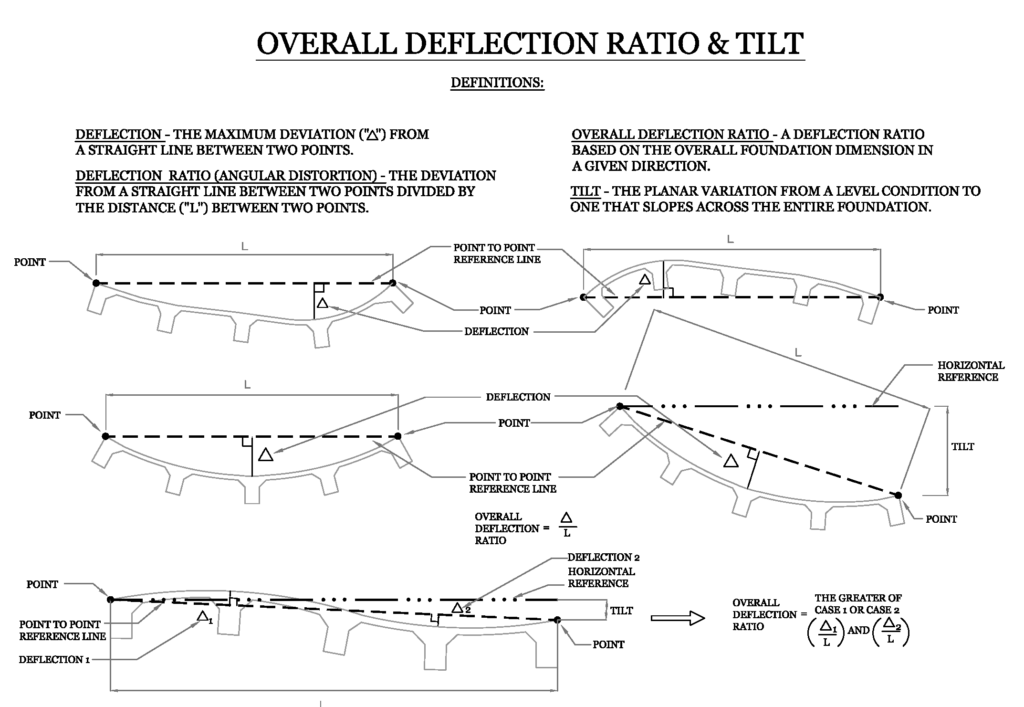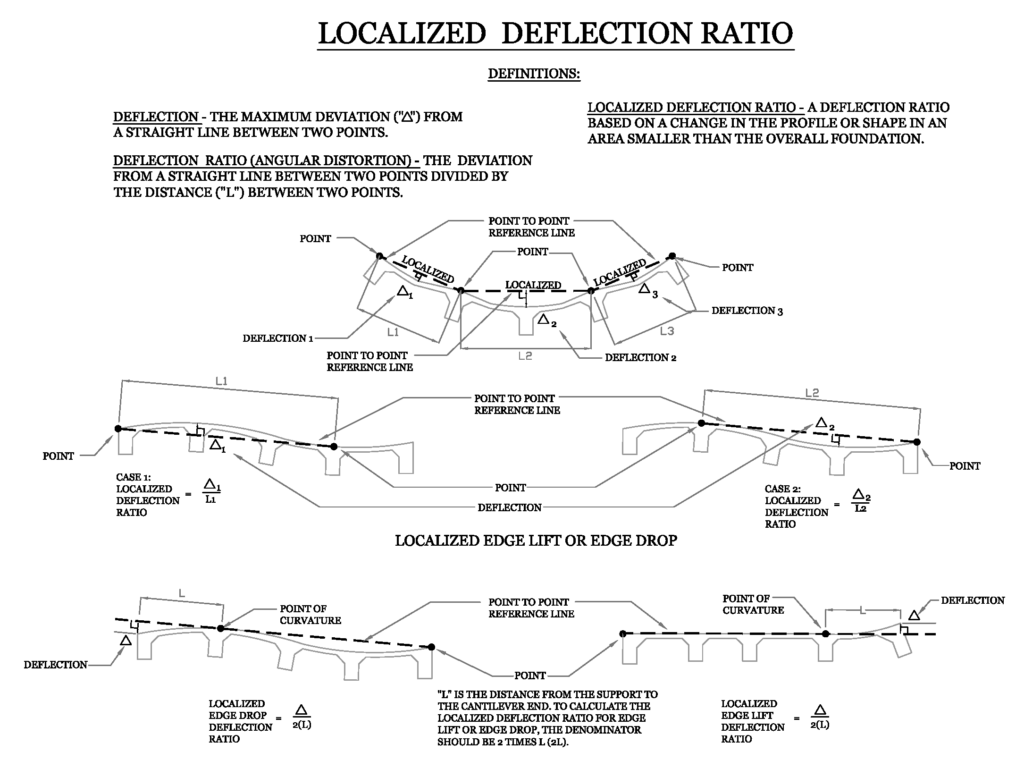Revisions to ASCE Texas Section Residential Foundations Guidelines – Part Two

This is part 2 of a series about the revisions to the ASCE Texas Section Residential Foundations Guidelines document.
by Robert F. (“Bob”) Pierry, Jr, PE
ASCE Texas Section Residential Foundations Oversight Committee Chair
December 2022
Part One published August 2022
Part Two
The ASCE Texas Section (“Section”) adopted Version 3 “Guidelines for the Evaluation and Repair of Residential Foundations” (“Forensic Guidelines” or “document”) on April 1, 2022. This document is intended to provide guidance for Professional Engineers (PE) who evaluate existing residential foundations.
Committee Background and Timeline for Changes to the Forensic Guidelines – Version 3
The ASCE Texas Section received additional comments in the form of a letter from a Professional Engineer, who is also a Texas Section member, in December of 2018. Subcommittee Chair Marshall Addison, PhD, PE asked this member to re-submit his comments in a manner that conforms with the Adopted Changes section of the document, which he did in January of 2019. The author and Brian Eubanks PE submitted additional prospective changes in February of 2018, as did Subcommittee member Gary Osbourne PE in March of 2019. These submittals prompted the reconvening of the Forensic Subcommittee by Zoom teleconference on August 24, 2019. The ASCE Texas Section Residential Foundations Forensic Subcommittee voted to appoint Ken Struzyk PE as Chair of the Subcommittee to replace Marshall Addison, PhD, PE, and voted to accept new members Brian Eubanks PE and Rene Gonzales during this call. The Forensic Subcommittee also resolved to schedule an “in person” meeting based upon Subcommittee member availability. The Subcommittee held this in-person meeting on October 5, 2019, at the Texas Section office in Austin. Subcommittee Chair Ken Struzyk PE together with Subcommittee member Phil King PE submitted additional prospective changes prior to the October 5, 2019 meeting.
The Subcommittee voted to accept additional comments until the next Subcommittee meeting, held on October 5, 2019, provided they included proposed changes. The Subcommittee also began deliberation of the various changes proposed to date during the October 5, 2019 meeting. The National Foundation Repair Association submitted additional comments in the form of a letter emailed to Chair Ken Struzyk PE on December 5, 2019, just prior to the next Subcommittee meeting held on December 14, 2019. These comments did not include suggested language changes.
The Subcommittee held additional “hybrid” (in person and Zoom) meetings on December 14, 2019, August 28, 2020, November 21, 2020 and March 6, 2021. The Subcommittee voted to approve the draft of Version 3 at the March 6, 2021 meeting, and send it to the Foundation Oversight Committee for review and comment.
The Oversight Committee held a hybrid meeting on June 11, 2021 to consider the Version 3 draft. The Committee reviewed all the changes proposed by the Forensic Subcommittee during this meeting. The Committee proposed comments regarding specific changes for the Subcommittee to consider. The Oversight Committee held an additional meeting via Zoom on October 1, 2021, at which further discussion of the proposed changes occurred. After this discussion, the Committee voted to send the comments back to the Subcommittee for consideration.
The Subcommittee held a hybrid meeting on October 28, 2021 to consider the comments submitted by the Oversight Committee, agreed with some of these comments and made corresponding changes to the draft document. Further review and corrections to the previous meeting notes occurred at another Subcommittee meeting held via Zoom on February 11, 2022, after which the Subcommittee voted to send the revised draft back to the Oversight Committee after the corrections were made.
The Oversight Committee held a brief Zoom meeting on March 14, 2022, at which the Committee voted to send the draft document to the Texas Section Board of Direction for approval. The Board of Direction approved Version 3 on March 31, 2022, with an effective date of April 1, 2022.
After the Texas Section posted Version 3 on its website, the author noticed that the list of changes at the beginning of the document did not match the actual language in the text in a number of instances. The Texas Section corrected these issues and posted the final document on the Texas Section website on June 3, 2022.
Two significant changes to the document are the combining of the “Overall Deflection” and the “Localized Deflection” subsections in Section 5 into a single “Deflection” subsection, and the inclusion of drawings depicting how overall deflection, tilt and localized deflection are defined by the Forensic Guidelines.
Combining the deflection sections came as a direct result of original comments submitted in late 2018. As noted above, most third-party structural warranty companies refer to the Forensic Guidelines in their performance standards. These standards, however, single out overall deflection, and in some cases specifically indicate that localized deflection should not be considered. By combining the “Overall Deflection” and “Localized Deflection” subsections, practicing PEs should place less emphasis solely on overall deflection.
Along the same lines, many of those who submitted proposed changes have experienced incorrect calculation of deflection and tilt, as defined in the document, by some practicing PEs. Version 3 addresses this issue by adding Figures 1 and 2 to clarify the correct methods of calculating these parameters.


Ongoing Communication Efforts
The Texas Board of Professional Engineers and Land Surveyors (“TBPELS”) contacted the Texas Section in February of 2022, requesting a meeting to discuss complaints they have received from homeowners regarding levels of service provided by Professional Engineers who inspect residential foundations. A Teams meeting was held with TBPELS Executive Director Lance Kinney PE, TBPE Director of Compliance and Enforcement Michael Simms PE, ASCE Texas Section Executive Director Jenni Peters, CAE, and Forensic Subcommittee Chair and the author Ken Struzyk PE. TBPELS’s concern was that the complaining homeowners believed they were not receiving thorough evaluations from PEs conducting Level A inspections. While this level of service is described as a “report of first impressions” in Section 3.1.1 of the document, the TBPELS indicated that the homeowners did not clearly understand this when they hired the Professional Engineer. The TBPELS indicated that strengthening the language in the document to include clear communication about the limitations of a Level A inspection would be quite helpful to them when evaluating complaints. The TBPELS was unaware that Version 3 was under development and understood that the process was too far along to consider additional changes. All parties agreed that we would work together to address this issue during future version consideration.
Conclusions
The continuing effort to create and revise guidelines for residential foundation engineering undertaken by the Texas Section ASCE is a complex, but worthwhile endeavor. This effort has involved more than 50 Texas Section members over a period of more than twenty years with an estimated value in the millions of dollars, the all-volunteer effort continues to provide useful guidance to practicing Professional Engineers and others, including governmental agencies.
The ability to consider and adopt changes to the documents is essential to keep the guidelines current and appropriate. We, therefore, encourage all ASCE members whose practice includes residential foundations to carefully review the documents and submit comments and proposed changes they deem appropriate according to the established procedure.
Each of the guideline documents reflect the experience, education, and practices of numerous licensed Professional Engineers across Texas, and as such provide insight into what many engineers consider to be appropriate residential foundation engineering practices. The guidelines are expected to improve residential foundation engineering practices and thus improve residential foundation performance. They in no way, however, replace the basic need for sound engineering judgment based on appropriate education, experience, wisdom, and ethics in any particular engineering application.
References
Foster, Pierry & King, “Creating Guidelines for Residential Foundation Engineering”, Proceedings, Geo-Frontiers 2005.
Foster, King & Pierry, “Status Report on Manuals of Practice – Residential Foundations”, Proceedings, Texas Section ASCE Fall 2000 Meeting.
Foster, King & Pierry, “Texas Section ASCE Residential Foundation Engineering Practice Manuals”, Proceedings, Texas Section ASCE Spring 2003 Meeting.
Meyer, Kirby, PE, Comments on “Report of the Residential Foundation Committee, Texas Board of Professional Engineers”, Texas Civil Engineer, Fall 1999.
Pierry, Addison, King and Foster, “Revisions to Texas Section ASCE Residential
Foundation Documents”, Texas Section ASCE Spring Meeting 2009.
Texas Board of Professional Engineers, Policy Advisory 09-98A, 1998.
Texas Section ASCE, “Recommended Practice for the Design of Residential Foundations”, Version 1 (2002) and Version 2 (2008). Texas Section ASCE, “Guidelines for the Evaluation and Repair of Residential Foundations”, Version 1 (2002) and Version 2 (2009).


